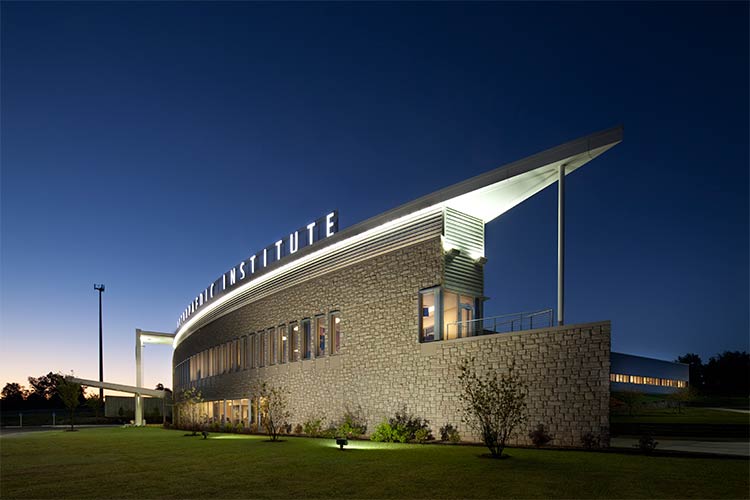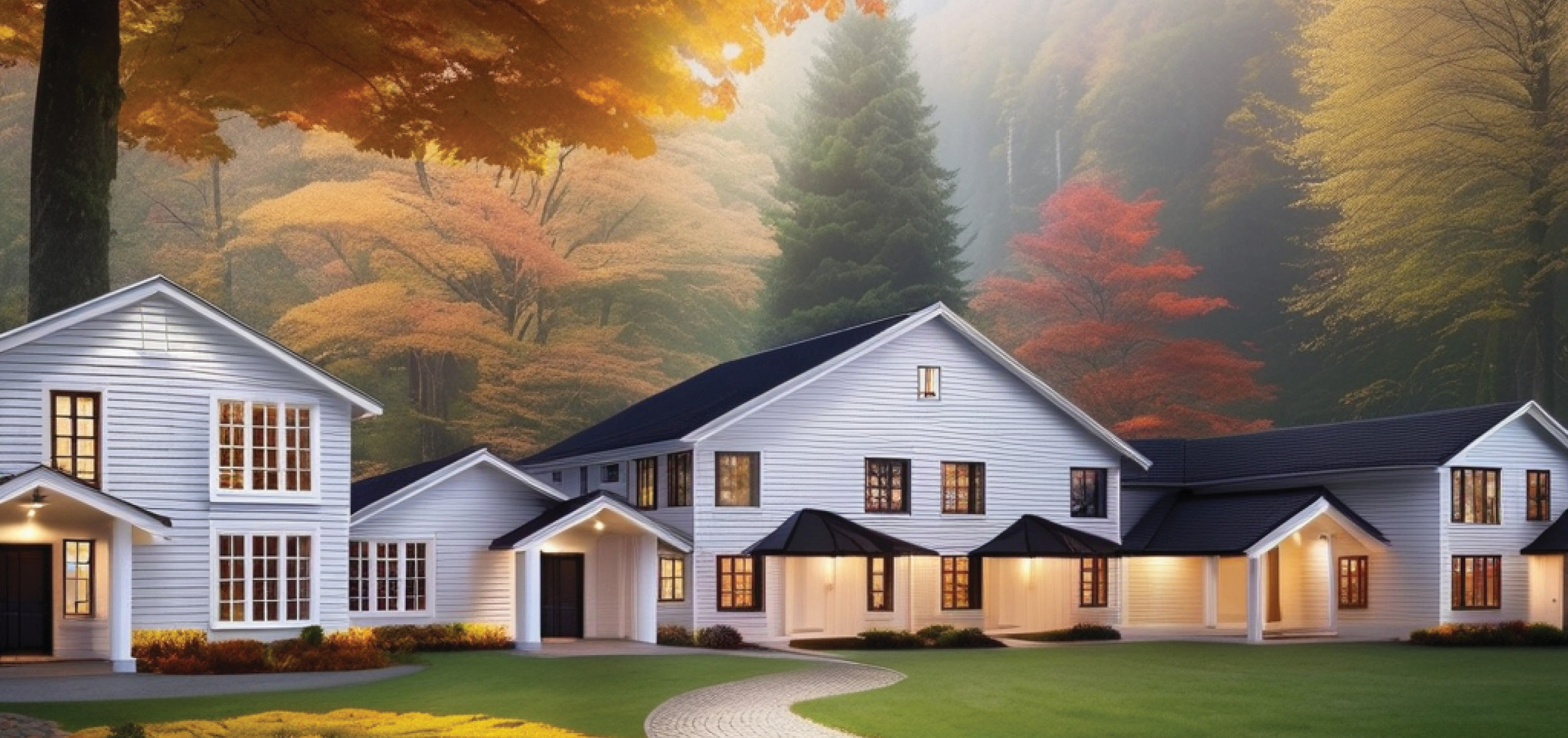Intergenerational living continues to be a hot topic in the senior living industry. The primary concept is to generate symbiotic relationships through intentional programming and informal interactions between generations of residents. Of course, intergenerational living is not, in and of itself, a new concept. In many cultures around the world, multiple generations of families living together is still the status quo. For some, “grand family” living, where multiple generations live together helping to raise children, care for their elders, and share the burdens of life, is a necessity. And it is often a positive experience. While, “grand family” living has been minimized in modern American society, numerous studies of “blue zones” suggest this type of living arrangement is believed to be one of the contributing factors in exceptionally long lifespans. “Blue Zones” are regions of the world where people tend to live longer lives, often reaching up to age 90, and 100, and beyond. (https://www.bluezones.com/)
The senior living industry recognizes the middle market gap that exists between government-subsidized housing and the high-end private

pay market. This gap is anticipated to widen as the baby boomer generation ages into care. Intergenerational living can offer a bridge to fill the gap by providing an environment that promotes beneficial relationship building between neighbors, thereby decreasing dependency on institutionalized care.
Beyond simple demand and supply, intergenerational communities can offer the next generation of ageing adults the opportunity to stay engaged, continue learning, and contribute. Today, ageing adults are searching for more than amenities and cruise ship style services; they desire to maintain a sense of purpose and meaning as they transition to residences offering long-term support. Intergenerational communities can cultivate opportunities for residents to remain engaged by facilitating interactions with all generations to help build meaningful relationships, and they create opportunities for residents to continue to learn and find purpose.
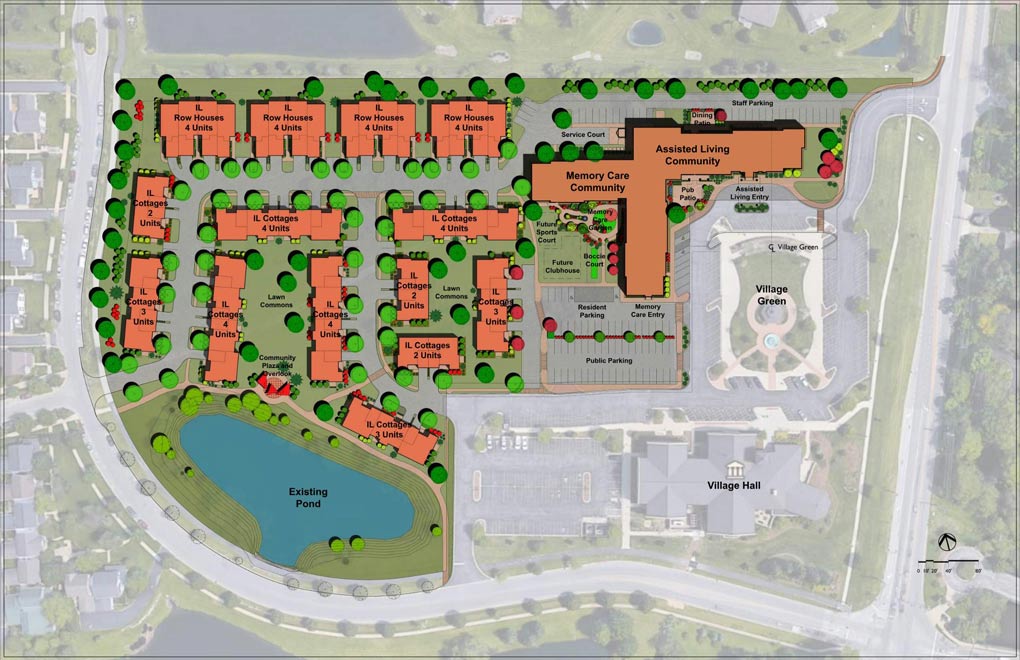
As we study its implementation, it is important to note the differences between intergenerational and multigenerational living. In broad terms, the simple adjacencies of different generations can be considered “multigenerational living.” Large residential developments can often be described as multigenerational by the inclusion of senior living buildings in conjunction with market-rate apartments, single-family homes, shopping, services, and so on. This proximal adjacency, while a beneficial first step in breaking down ageism and generational segregation, falls short of intergenerational development. Who would argue against the desire of senior residents to be close to schools and parks to be able to see the life and vitality of children running and playing daily? Yet, adjacencies alone are not enough.
Just as a picnic table sitting in a field fails to be a picnic, multiple generations living in proximity without interaction fails to create meaningful intergenerational experiences. Spaces should be designed to provide services, amenities, and programs that are used by multiple generations. It is through planned activities as well as through casual encounters and interactions that meaningful intergenerational relationships can be born and fostered. It is equally important to recognize this is not a “if you build it, they will come” proposition to be solved by architecture alone. It requires intentionality by all participants, and a healthy dose of managed and orchestrated events.
In this way, intergenerational living developments or broader communities can be viewed as being on a continuum, or sliding scale of engagement, between generations. Levels of cross-generational engagement span from simply learning about other generations to interacting through distance, such as through pen-pal programs, to more structured and recurring programs including volunteering or mentoring programs. This continuum extends all the way to a truly connected community in which real collaborative relationships are formed.
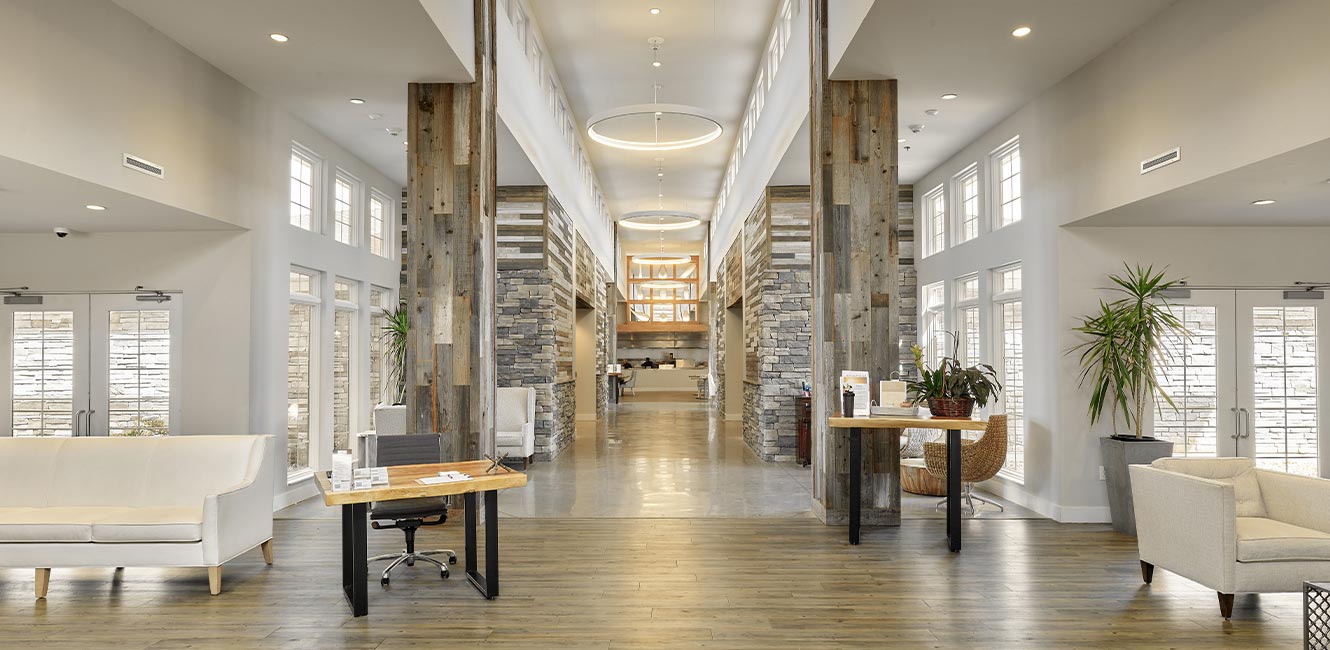
The value of building and maintaining intergenerational relationships is not superficial. These relationships can truly benefit all parties, from fighting loneliness in seniors to increasing cooperation and social skills in young children. Parents and caregivers can benefit from an extra eye or a broader network for childcare in an emergency. Even staff can experience heightened morale and increased job satisfaction in their role, leading to greater retention.
Challenges
While the benefits of intergenerational living are quite clear, the challenges to building a sustainable, intergenerational community are confounding and numerous. We have found a few key challenges that independently are not wholly unique to intergenerational models of development, however, in combination, they represent significant hurdles to the broader adoption of this model of development and community engagement.
Stigma
One of the first challenges is the way senior living facilities are viewed by the public. A 2020 poll found 61% of respondents would rather die than move into a nursing home (Novotney). Broad segments of the population do not interact with modern senior environments and have awareness of the beautiful places that are being created to allow our elderly to live in a place of dignity. How can the senior living industry convince multiple generations to live together, given such negative connotations?
Zoning
Most zoning codes do not identify areas specific to senior housing. As a result, most communities struggle with fitting new senior living developments into residential or institutional classifications. Rezoning is often necessary to allow 65+ communities to be built in residential districts, or in edge neighborhoods between residential and commercial districts. The challenge becomes more complex when multifamily components with limited age restrictions, a childcare, an adult daycare, or other commercial retail spaces are added to the mix.
Licensing
As with zoning, licensing is also complicated by the mixing of uses. Organizational structures become difficult to form as entities need separate spaces, separate budgets, and separate ownerships. Where symbiotic relationships could thrive within cross-functional use, the efficiencies are often lost due to licensing structures and the requirements for separate and distinct spaces.
Financing
Ideally, every intergenerational community would be customized with spaces and care offerings that fit each resident’s needs. Successful intergenerational communities have been able to do this, but it often requires wealthy benefactors, nonprofit support, or other alternative financing models. The metrics and proformas required for traditional financing are typically not available for intergenerational living ground up development. Fundraising to get these projects off the ground can take many years, and all the benefits that intergenerational living can bring are delayed or may never come to fruition if funding goals aren’t met.
Comingling
The ultimate challenge might be designing spaces that balance intentional interactions between generations but also minimize the conflict that may arise by comingling diverse groups of people. Everyone has experienced the dynamics of co-living — the conflicts at home between family members or the spats between friends living together. So, what considerations need to be made when intentionally designing for people at vastly distinct stages of life?
The Workshop
Successful Intergenerational communities seem to grow from grassroots efforts, by individual champions in the senior living industry willing to push past the hurdles and reimagine senior living. These champions believe in the benefits of intergenerational living, and go to battle against the host of challenges, in lengthy bouts of determination and willpower. These individuals hold a wealth of knowledge due to the lessons they have learned through trial and error. Wouldn’t it be valuable to document some of those lessons and give others a leg up on navigating the process? Could we identify some tools or steps that have been successfully implemented to move the needle on creating intergenerational communities?
The Environments for Aging Conference, hosted in Milwaukee in April 2022, seemed like the perfect place to start that conversation. A conference filled with industry professionals, all searching for ways to improve the lives of senior residents, brings together those industry experts and sets the stage to create a roadmap to overcome the challenges and provides resources for others who want to pick up that charge.

Through an hourlong session, a team from ERDMAN looked to leverage Integrative Thinking and disrupt the status quo to tap into the collective knowledge and experiences of the attendees themselves. Recognizing the scale and complexity of the problem, and given the limited time, the goal was not to solve the problem, but rather to identify minor but attainable steps that are within the power of the individual to nudge the needle toward normalizing intergenerational communities.
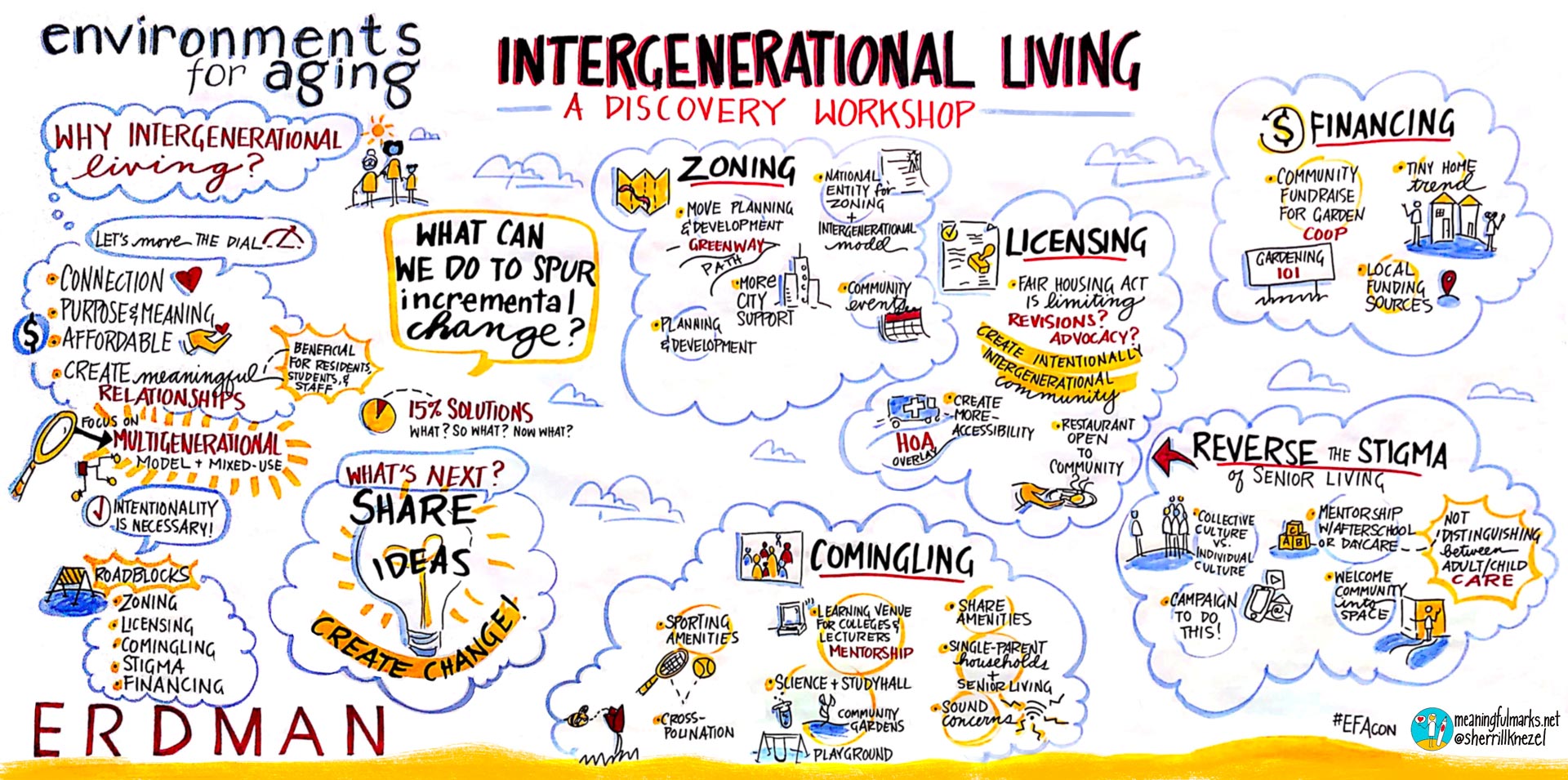
The audience of design professionals, operators and developers was engaged to reflect on the benefits and hurdles of intergenerational community development before sharing their idea with a neighbor. They built upon each other’s ideas, approaching the solutions with a “yes, and” mentality. With enhanced solutions, everyone self-organized into affinity groups corresponding to the challenge their idea most directly solved. These larger groups, built once more upon the solutions that had been generated.
Through the broader discussion, several commonalities and themes emerged and were captured as graphic notes. These notes serve as a roadmap for next steps to advance the continuum of intergenerational relationships.
What, So What, Now What?

There seemed to be one overarching theme across all challenges — the need for community outreach and understanding of what senior living is and how it differs from the preconceived notion of an “old folks home.” Although the depth of this conversation was born out of the discussions around the stigma of senior living, there seemed to be undertones of this idea when addressing all of the challenges. Could a marketing campaign illustrating the lovely environments in senior living be targeted to the public and make the zoning and entitlement process more uniform from municipality to municipality? Would outreach efforts to bring people into existing communities help lawmakers and the public see cross-functional opportunities to simplify licensing requirements? A universal need for visibility into the industry is clear across all aspects.
Perhaps the extension of this awareness can also be an umbrella to categorize some of the other ideas that were suggested to help overcome the challenges of creating intergenerational communities. Some simple first steps were suggested that could have a catalytic
impact for change. Opening dining facilities up to the greater community and marketing it as a restaurant instead of a dining room could bring people into the community that many have never visited. Rebranding adult day care as day clubs, or perhaps eliminating the age barriers for care altogether — to have a mixed care group with symbiotic relationships between children, seniors and all ages in between. Even just adding guest room spaces for rent to family and friends would give people firsthand experience of what it is like to live there or provide some much-needed housing for staff.
The built environment should include public-private spaces, shared garden spaces or other site amenities that draw the community in, and comfortable spaces that provide opportunities to comingle, as well as private spaces that allow a sense of personal space and a feeling of home. In short, great spaces that residents are excited to share and that nonresidents want to experience.
Placemaking, in connection with intergenerational design, is important in reducing misconceptions about senior care environments. As a design team, it is important to understand the stigma around senior communities to help generate design solutions that disprove those perceptions. In understanding this, we can create places that seniors and staff look forward to; we move toward a more holistic continuum of care, where the resident experience is tied to operational success and increased satisfaction.
The intergenerational model promotes a supportive community, where social interconnectedness thrives, improving resident experience and encouraging a more appealing outlook on senior communities.
1. Novotney, Amy (December 9, 2020). “More than 6 in 10 Americans now say they would rather die than live in nursing home: survey” https://www.mcknightsseniorliving.com/home/news/business-daily-news/more-than-6-in-10-americans-now-say-they-would-rather-die-than-live-in-nursing-home-survey/#:~:text=In%20a%20blow%20to%20the,conducted%20by%20the%20Harris%20Poll.
2. Blue Zones https://www.bluezones.com/

